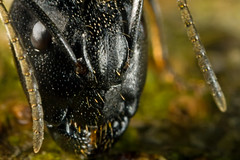Don’t get me wrong, diffraction is a real problem. But it’s not as bad as some would have you believe. I thought my limit for shooting at three times life size was F8 –any higher and diffraction would rob me of the detail that I'd get from any increase in depth of field. At least that’s what I read. But then I saw Cyrus’s gallery and was blown away by the images! Granted, he is losing image detail to diffraction but the overall composition and lighting of the photos makes up for it.
It’s the image that matters –how you get there is irrelevant…
So after looking at Cyrus’s gallery, doing some experimenting, and deciding what my own acceptable level of detail is I made a few adjustments. I’m now shooting at 3x life size with my Fstop set to 16 instead of 8. I’m getting twice as much depth of field and there is still some detail in the ant’s compound eye. At F22 that eye looks flat and I don’t like it, but if I need the extra depth of field I wouldn’t hesitate to stop the lens down.
I could resort to focus stacking to get more depth of field as soon as someone tells me how to completely freeze an ant’s motion –without putting the critter in the freezer… ;)


2 comments:
Something to consider: When you start stacking lenses and dipoters the effective focal length changes; hence the aperture setting on the primary lens no longer shows the correct value. Adding dipoters shortens the focal length and thus decreases the f/number (increases the apparent aperture). Also, macro lenses at 1:1 can have focal lengths significantly shorter than nominal. This will also decrease the f/number. The bottom line is that while you have dialed in f/16, you may, for example, actually be shooting f/11. The good news is that you can probably stop down your primary lens even farther without worrying about diffraction effects.
Thanks for the comment Glenn!
The problem is that increasing the magnification has the opposite effect -the Fstop increases (aperture gets smaller). At F22 that same ant would have almost no detail in its compound eye (I tried it and didn't like the results).
Post a Comment